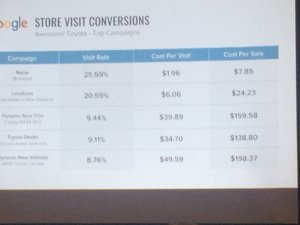Ryan
The challenge here is separately fact from fiction. Over 80% of store visits I have analyzed associated with the SEM campaigns buying the dealership's name or location. So, once you see that, it is clear that Google is not efficient in bringing incremental new shoppers to the dealership's website. The shoppers it brings are likely cost effective, but Google is attempting to continue its story that it takes credit for the impact created by other brand influences. When you take the shoppers from GMB and Branded campaigns, many will come to the conclusions that the King has No Clothes.
Brian, on the surface this is true, but it's a false conclusion. To separate fact from fiction, you need to look at OEM Co-op programs separately from properly run independent marketing programs.
First, OEM websites suck. It's almost impossible to create a decent custom landing page for SEM campaigns. That's why their Home pages work better for conversions. If dealers want to get the most out of their SEM spend, they need a non-OEM site that allows them to create landing pages that convert. Second, OEM SEM agencies suck. Every one I've ever looked at grossly overcharged and sucked really bad at SEM. Third, since the easiest thing to do is buy a dealer's name and location, it's not surprising that that's where the majority of the leads are coming from. Dealers don't want to spend money on overpriced campaigns to sell cars that don't work, and since OEM SEM agencies overcharge and suck at doing those, it's no surprise OEM SEM doesn't produce more vehicle leads and sales. Third, OEM Co-op SEM programs are not designed to sell cars for dealers. They are designed to make money for the OEM, the OEM's agencies and to extend the OEMs branding. Fourth, the OEMs and their agencies will not give dealers access to the data to properly manage these investments.
Dealers are left with a choice, rely on the OEM Co-op programs and accept mediocrity, or get what they can out of the OEM Co-op programs and develop a completely separate marketing program to sell more new/used cars and service by taking market share from their competitors. This means having a real website capable of creating custom landing pages that convert, having Google Analytics properly installed and using it, having their own Google Ads accounts, having their own Facebook Ad Manager accounts, taking control of their Google My Business accounts and integrating all of these.
Done properly, SEM is one of the most effective means for generating incremental car and service specials. But it has to be done properly and priced fairly, which leaves OEM Co-op programs out of the picture.










